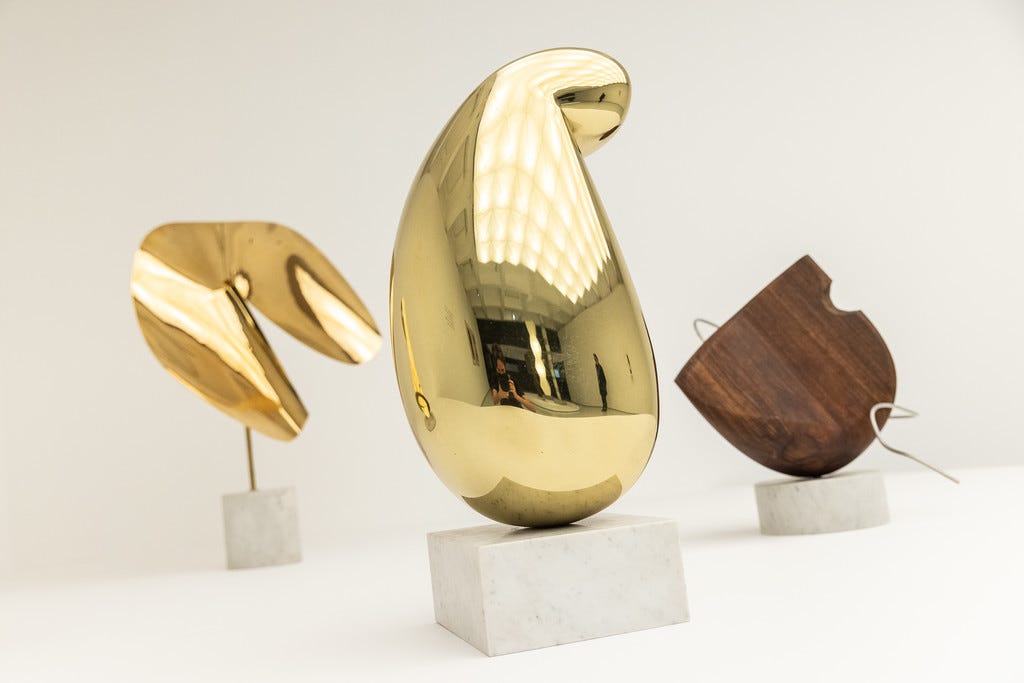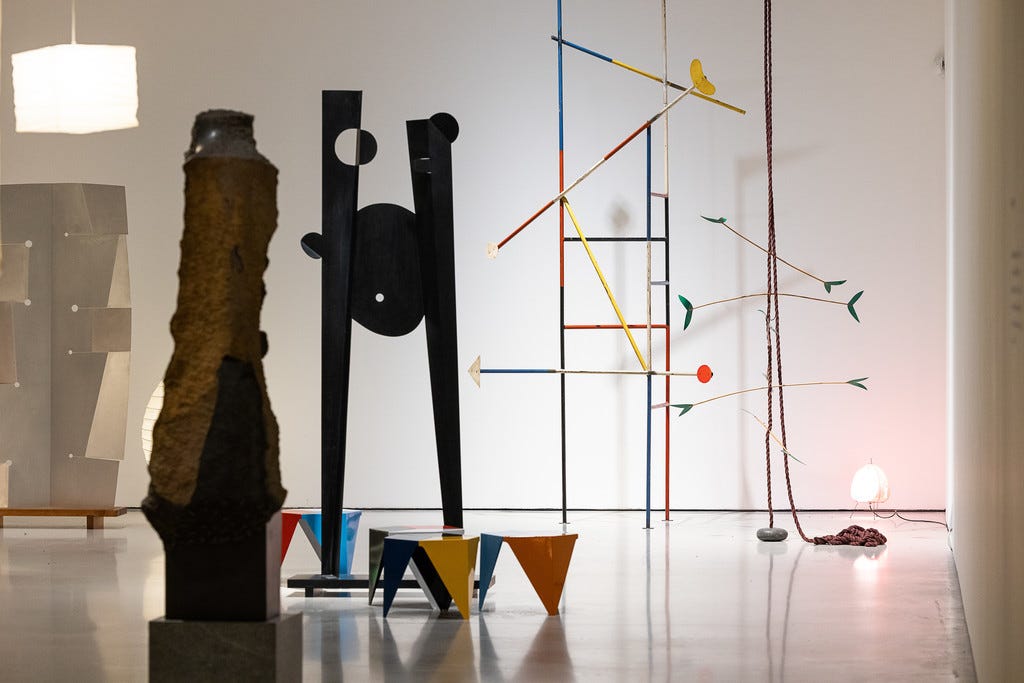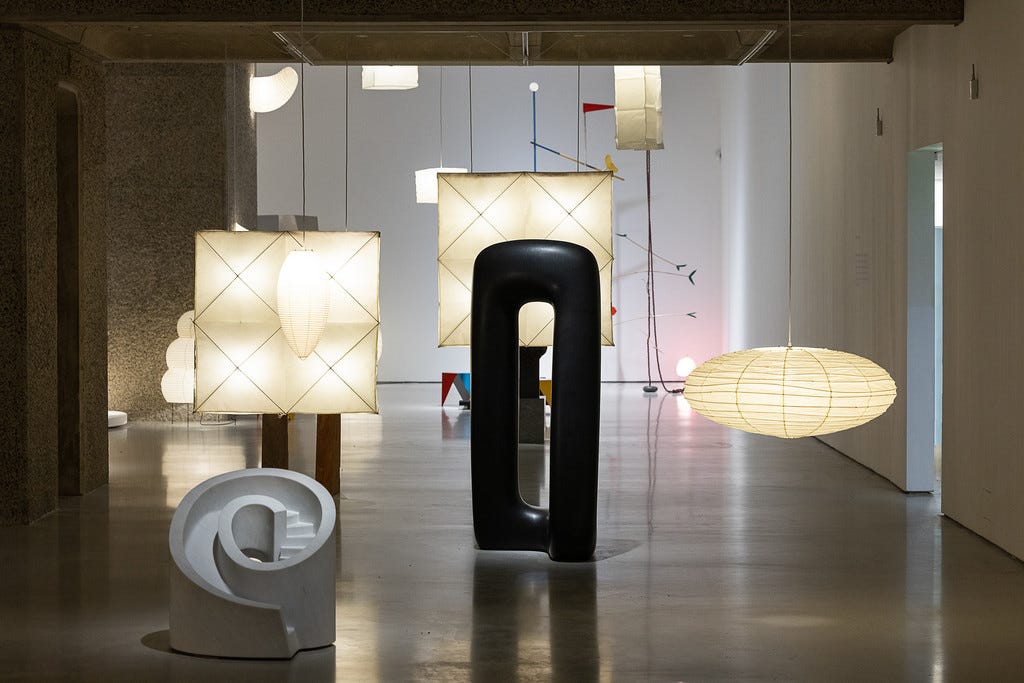Edition 16 — Noguchi
A review of Barbican's Noguchi retrospective 🪨💡, a writing workshop, and a reader's poll 🖋
Heyyy.
It’s been a minute.
It’s been a hot minute. Sprout took a break over the summer to focus on online course offerings and learning workshops. More on online courses soon (🥳) and read about our next workshop below 🔈
We are a small team (me), and we (I) have a lot to juggle, so something had to give. We (I) had every intention of launching newsletters again in September but life kind of got in the way. In addition to working on Sprout, I continue to freelance, work, study, and attempt to keep a social life. It’s fun. But so is napping. We (me) are feeling a little burnt-out. 🧨
Here we are, mid-October and (gently) ready to go return to the newsletter community. To make the most of the final months of 2021, Sprout (I) would love to hear what you want to read. To help us (me) curate our upcoming schedule, please take a few minutes to answer 2 simple questions and vote for what features Sprout will publish. All votes are anonymous and no personal data is requested. It should take less than 2 minutes to tick boxes. You can do so here.
One of our (my) favourite things about quarantine lifting has been galleries and museums opening on a more regular basis. It feels good and I’m so here for it. 🎉October is a busy art month in London with the arrival of Frieze, and there is a lot to see and consume.
With that said, we (I) filled our cup ☕️ with a recent trip to the Barbican to see Isamu Noguchi’s retrospective.
Let’s dive in. ⬇️
Noguchi.
A Barbican retrospective.
I spent a chunk of my childhood and young adult years in South East Asia where the weather toggles between monsoon and non-monsoon season. Although I will never stop adoring bi-annual seasonal changes of life on the equator, it means I am always charmed by the click of transitional seasons falling into place. I forget that life is cyclical, not binary.
Fall Sunday afternoons in a big city are a particular kind of magic. Wool coats, pale blue skies, takeaway coffees and newspapers tucked into elbows. Life is back! Culture is back! The Barbican, in particular, was heaving. It’s as though the past 18-months has made cultural junkies out of all of us. We are all on the hunt for a fix.
Noguchi was torn to shreds by The Guardian. There is no punch to it, no emotional or psychic energy, just a gentle progress of clever but harmless creations, wrote critic Jonathan Jones. Initially, I found myself internally agreeing with his suggestion that the exhibition is more ‘design’ than ‘art’. A moment later I thought — who the heck cares at this point? This is 2021 and would it really be all that bad to see an exhibition of gentle creations? Pfft — move over, Jones. In any case, the review did not dissuade the crowd. The Barbican was busy in a way that reminded me of a simpler time; 2018, or even 2019.
As a space, Barbican is inviting. Visitors tend to hang out and sink their teeth into the cultural experience in a way you don’t see at other galleries. People really hung out at Noguchi. They leaned over balconies admiring sculptural works below. They sat on benches in exhibition aisles and were so taken with the show that phones stayed tucked into pockets and purses. The crowd seemed happy to dither. Perhaps there is something to be said in favour of the abstract elegance and beautifully spaced Noguchi works.
Low lighting throughout the space is an obvious nod to Noguchi’s belief that art, life, and beauty are intertwined. The show opens with an artist quote; Art for me is something which teaches human beings how to become more human. Immediately it becomes apparent that this exhibition isn’t just about looking. It’s about experiencing. Noguchi-designed furniture and lighting fixtures set that tone, and the art is then woven through. Perhaps this is where Jones stalled.

Isamu Noguchi was born between worlds to an American mother and Japanese father. Born in 1904 in LA, Noguchi spent most of his childhood in Japan. He lived through astounding highlights of the twentieth century; two world wars and the attack on Pearl Harbour, and the Civil Rights Movement to name a few. As social and political movements relating to race, class, and citizenship played out on a global stage, Noguchi explored his bi-racial and global identity through his art. In 1952 Noguchi designed a memorial for those who lost their lives in Hiroshima (pictured above). His design was rejected on account of his American citizenship.

The exhibition is curated thematically. The upper level is dedicated to clustered periods of work that relate to a central theme ranging from politics to social change, immigration, and aesthetics.
A number of tall, column-like sculptures made of precariously placed materials dot the upper level. This is how Noguchi articulated his message. In fact, Noguchi’s tendency toward precariousness is arguably the most captivating element of the exhibition. He typically didn’t use lightweight materials that easily balance or fix into place. In fact, he didn’t use fixtures at all. Noguchi favoured natural materials and didn’t shy away from articulating complex concepts using solid, dense materials such as granite, wood, and marble. Noguchi’s sculptures are refined and soft. The intent behind them is loud and powerful. What Jones terms clever but harmless creations, I call — understated.
Take, for example, Monument to Heroes (1943). A column of makeshift ‘bones’ made of wood and string. The sculpture stands tall, and each element is delicately balanced in position. Standing next to it you have the feeling that if you breathed too heavily it might all come falling down. Which is exactly the response Noguchi sought to evoke. He dedicated this work to wartime aviators and the residue of bravery, blown by winds.
Converse to the upper level’s careful arrangement of Noguchi’s creative periods, the ground floor is more fluid. Large sculptures and lamps are peppered across the floor. Intricate works climb up the walls and expand in corners, such as set elements for Erick Hawkins’s Stephen Acrobat: Jungle Gym (1947) production (pictured far-right in the above image).
On the ground floor, visitors are wholly immersed in Noguchi’s art. Marble sculptures, wooden carvings, and warm, delicate light ensconce the space. It brings to mind the opening quote: Art for me is something which teaches human beings how to become more human. ▪️
📣 So you want to be a [better] writer?
Join the Writing and Editing workshop.
When: Monday 25 October, 7 pm UK time
Where: Zoom 🧑🏽💻👩🏻💻👨🏼💻👩🏿💻
Cost: Donation only 🪙 with bursaries available.
In this 90-minute workshop, expect to learn:
What makes a good piece of writing: style, voice, tone
How to integrate new writing techniques into your writing practice
Writing techniques that elevate your writing practice
How to self-edit: structure, language, style, word-count
The workshop will be filled with practical exercises so you can experiment with the support of a lecturer, connect with fellow writers, share your writing, and grow your confidence.
Expect group discussions, too, where any and all questions about writing are welcome! 🖋
Attending this workshop includes:
24-hrs to access a recording of the lecture if you can't make it in person
A downloadable e-workbook with additional learning exercises and notes to refer back to after the session
It's going to be a fun session! ⚡️ Think Hemingway-esque writing techniques delivered with 'good 4 u' level energy.
Book here, or respond to this message for a free ticket.
You should totes vote
From this point out it’s a sleigh ride into 2022. With this in mind, Sprout wants to publish the most interesting newsletters possible.
To help us with our mission, please take a few minutes to answer 2 questions and vote for what features we publish.
All votes are anonymous and no personal data will be requested. It should take less than 2 minutes to cast your votes here.










